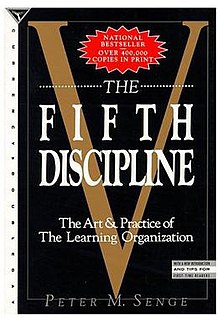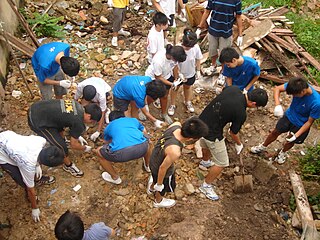
The Socratic method, is a form of cooperative argumentative dialogue between individuals, based on asking and answering questions to stimulate critical thinking and to draw out ideas and underlying presuppositions. It is named after the Classical Greek philosopher Socrates and is introduced by him in Plato's Theaetetus as midwifery (maieutics) because it is employed to bring out definitions implicit in the interlocutors' beliefs, or to help them further their understanding.
Empowerment is a set of measures designed to increase the degree of autonomy and self-determination in people and in communities in order to enable them to represent their interests in a responsible and self-determined way, acting on their own authority. It is the process of becoming stronger and more confident, especially in controlling one's life and claiming one's rights. Empowerment as action refers both to the process of self-empowerment and to professional support of people, which enables them to overcome their sense of powerlessness and lack of influence, and to recognize and use their resources. To do work with power.

Virtue ethics are normative ethical theories which emphasize virtues of mind, character and sense of honesty. Virtue ethicists discuss the nature and definition of virtues and other related problems that focus on the consequences of action. These include how virtues are acquired, how they are applied in various real life contexts, and whether they are rooted in a universal human nature or in a plurality of cultures.

The Fifth Discipline: The Art and Practice of the Learning Organization is a book by Peter Senge focusing on group problem solving using the systems thinking method in order to convert companies into learning organizations. The five disciplines represent approaches for developing three core learning capabilities: fostering aspiration, developing reflective conversation, and understanding complexity.

Service-learning is an educational approach that combines learning objectives with community service in order to provide a pragmatic, progressive learning experience while meeting societal needs.
Program evaluation is a systematic method for collecting, analyzing, and using information to answer questions about projects, policies and programs, particularly about their effectiveness and efficiency. In both the public and private sectors, stakeholders often want to know whether the programs they are funding, implementing, voting for, receiving or objecting to are producing the intended effect. While program evaluation first focuses around this definition, important considerations often include how much the program costs per participant, how the program could be improved, whether the program is worthwhile, whether there are better alternatives, if there are unintended outcomes, and whether the program goals are appropriate and useful. Evaluators help to answer these questions, but the best way to answer the questions is for the evaluation to be a joint project between evaluators and stakeholders.
In software development, agile approaches development requirements and solutions through the collaborative effort of self-organizing and cross-functional teams and their customer(s)/end user(s). It advocates adaptive planning, evolutionary development, early delivery, and continual improvement, and it encourages flexible responses to change.
An action plan is a detailed plan outlining actions needed to reach one or more goals. Alternatively, businessdictionary.com defines an action plan as a "sequence of steps that must be taken, or activities that must be performed well, for a strategy to succeed".
Lean software development is a translation of lean manufacturing principles and practices to the software development domain. Adapted from the Toyota Production System, it is emerging with the support of a pro-lean subculture within the Agile community. Lean offers a solid conceptual framework, values and principles, as well as good practices, derived from experience, that support agile organizations.
Reflective practice is the ability to reflect on one's actions so as to engage in a process of continuous learning. According to one definition it involves "paying critical attention to the practical values and theories which inform everyday actions, by examining practice reflectively and reflexively. This leads to developmental insight". A key rationale for reflective practice is that experience alone does not necessarily lead to learning; deliberate reflection on experience is essential.
The Ruhi Institute is an educational institution, initially operating under the guidance of the National Spiritual Assembly of the Baháʼí Faith in Colombia.
Competence is the set of demonstrable characteristics and skills that enable, and improve the efficiency or performance of a job. The term "competence" first appeared in an article authored by R.W. White in 1959 as a concept for performance motivation. In 1970, Craig C. Lundberg defined the concept in "Planning the Executive Development Program". The term gained traction when in 1973, David McClelland wrote a seminal paper entitled, "Testing for Competence Rather Than for Intelligence". It has since been popularized by Richard Boyatzis and many others, such as T.F. Gilbert (1978) who used the concept in relationship to performance improvement. Its use varies widely, which leads to considerable misunderstanding.
Scrum is an agile framework for developing, delivering, and sustaining complex products, with an initial emphasis on software development, although it has been used in other fields including research, sales, marketing and advanced technologies. It is designed for teams of ten or fewer members, who break their work into goals that can be completed within timeboxed iterations, called sprints, no longer than one month and most commonly two weeks. The Scrum Team track progress in 15-minute time-boxed daily meetings, called daily scrums. At the end of the sprint, the team holds sprint review, to demonstrate the work done, and sprint retrospective to continuously improve.
Action learning is an approach to problem solving. It involves taking action and reflecting upon the results. This helps improve the problem-solving process as well as simplify the solutions developed by the team. The theory of action learning and its epistemological position were originally developed by Reg Revans (1982), who applied the method to support organizational and business development initiatives and improve on problem solving efforts.
In the United States, the hospital incident command system (HICS) is an incident command system (ICS) designed for hospitals and intended for use in both emergency and non-emergency situations. It provides hospitals of all sizes with tools needed to advance their emergency preparedness and response capability—both individually and as members of the broader response community.
Educational psychology & Educational psychologists have identified several principles of learning, also referred to as laws of learning which seem generally applicable to the learning process. These principles have been discovered, tested, and used in practical situations. They provide additional insight into what makes people learn most effectively. Edward Thorndike developed the first three "Laws of learning:" Readiness,Exercise and effect.
Agile leadership is the craft of creating the right context for self-organisation. An environment where agile teams collaborate, learn from each other, get quick feedback from users and are focused on quality and continuous learning. He or she doesn’t micro-manage the people nor creates total freedom. Balancing between anarchy and strict structure is crucial in today’s markets. Developing and maintaining this right environment is often hard work. With focus on culture, ownership, mindset, feedback and long term goals.

Kanban is a lean method to manage and improve work across human systems. This approach aims to manage work by balancing demands with available capacity, and by improving the handling of system-level bottlenecks.

Extreme programming (XP) is a software development methodology which is intended to improve software quality and responsiveness to changing customer requirements. As a type of agile software development, it advocates frequent "releases" in short development cycles, which is intended to improve productivity and introduce checkpoints at which new customer requirements can be adopted.
Build Back Better was firstly defined and used officially in the United Nations Sendai Framework for Disaster Risk Reduction 2015-2030, which was agreed at the Third UN World Conference on Disaster Risk Reduction on March 14-18, 2015, held in Sendai, Japan. This document was adopted by the UN General Assembly on June 3, 2015.




